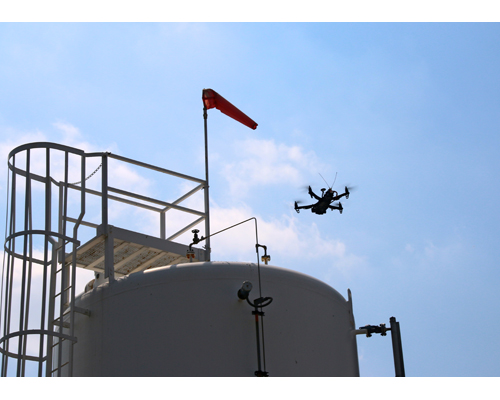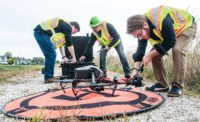

Unmanned aircraft systems—aka drones—have taken off in the civilian world. Nearly $17 million worth of drones were bought on eBay last year. Drones have come dangerously close to passenger aircraft, so it's no wonder that the Federal Aviation Administration fears disaster—thousands of tiny helicopters with spinning rotors and cameras are flying through the air.
Despite the concerns, however, the FAA knows that drones will become a vital part of the commercial environment. Congress demanded that the FAA come up with rules safely integrating commercial drones into civil airspace, and on Feb. 15, the FAA released those proposed rules. Construction stands to benefit from drones as much as any industry. They save money and promote job safety. Drones with cameras can inspect high elevations or projects built on difficult terrain without erecting scaffolding. Drones can detect damage and monitor building progress. Drones can provide onsite security systems.
 |
| HIGHLAND |
As they become more powerful and precise, drones could perform erection work in lieu of cranes—although drones of that size would be subject to an entirely different set of yet-to-come regulations. In fact, the construction industry is one of the few that has already received the FAA's blessing to use drones for commercial purposes, even before the new rules become law.
Several months ago, it was unclear whether FAA permission was required to fly a drone for inspection purposes on private property. That's because an administrative law judge ruled that drones were "model aircraft." The FAA does not regulate model aircraft. However, in November, the National Transportation Safety Board overruled that decision, finding that drones are aircraft and that FAA regs do apply to them.
But currently there are no regulations pertaining to commercial drones. The rules the FAA proposed in mid-February will allow 55-lb-and-under drones to fly up to 500 ft at speeds of up to 100 mph in daylight and within sight lines. The proposed rules require only that the drone operator obtain a permit—not a pilot's license—which would cost about $300 and need to be renewed every two years. These proposed rules are more lax than some were expecting, but they are not yet law.
Until they are law, expect the FAA to maintain its current position: "Anyone who wants to fly an aircraft—manned or unmanned—in U.S. airspace needs some level of FAA approval." This may not be entirely true—the FAA does not control all airspace—just airspace over 18,000 ft and lower when it's near major cities, airports and other designated structures. But up to about 700 ft, away from cities, airports and other structures, the airspace is "uncontrolled." There, the FAA has no authority.
A construction company could argue that if its site is in uncontrolled airspace, it can use a drone. But the FAA still claims a policy against that, and going against policy is likely not worth the expense of taking on the FAA. Instead, a contractor, until the new regs become law, should obtain an FAA Section 333 permit.
That permit exempts the user from the FAA's ban on commercial drones and certifies a particular drone for airworthiness. To obtain one, the applicant must register a drone with the FAA and submit a petition explaining why the exemption should be granted. Then, the applicant must apply for a certificate of authorization, which makes FAA air traffic control facilities aware of the proposed drone operations.
To date, the FAA has received 342 petitions and granted 24 of them. Many requests are pending. They have been granted to film companies and for real estate and agricultural photography as well as for inspections of oil rigs and flare stacks and monitoring of construction sites. Construction firms appear to be on better footing with the FAA than other industries because construction drones are not delivering products across cities or states. In line with the proposed regs, inspection drones usually stay within sight lines on a single piece of property.
The release of the new regs confirms that drones will become part of commercial industry. But the process for rule comment, approval and implementation can take up to two years. So, for now, contractors should prepare for yet another step to their permitting process and book spots for employees in the already popular drone flight classes.
Nicole Highland is an attorney at Vedder Price PC in Chicago. She practices nationwide in construction law. She can be reached at nhighland@vedderprice.com.


Post a comment to this article
Report Abusive Comment